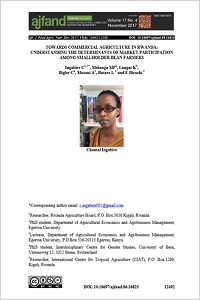Towards commercial agriculture in Rwanda: Understanding the determinants of market participation among smallholder bean farmers
Abstract
Agricultural transformation is key to poverty reduction and food security in sub -Saharan Africa (SSA). In Rwanda, this transformation has focused on shifting subsistence – based production to market - oriented farming. Over the last one decade and a half, major emphasis has been placed on the intensification of production systems, promotion of farmers’ cooperatives, and enhancement of farmers’ access to markets. Although the country recorded an increase in food crop commercialization, subsistence farming is still prevalent amongst smallholder farmers. Yet, in the few studies conducted on agricultural transformation, smallholder commercialization has received scanty attention. As the country aims to achieve commercialized agriculture, there is a need to understand what factors can influence farmers’ decisions to participate in the output markets. This study analyses the levels of market participation and drivers of output commercialization, using a sample of 256 Common bean farmers from northern Rwanda. A double -hurdle model was used to analyses the data. Results indicated that 30% of the farmers participated in the market with an average commercialization index of 0.42. Land size, agricultural training and group membership of household head had a positive effect on households’ participation to bean market. The distance to the nearest access road that can be used throughout the year reduces the probability of commercialization at household level.
The degree of market participation was positively influenced by price, education level of the household head and livestock income. On the other hand, distance to key markets had a negative effect on the degree of households’ commercialization.
The findings of this paper show that participation in bean markets is still low, with disparities in the commercialized quantities amongst those who participate. Female -headed households were more likely to participate in bean markets, selling higher volumes than male - headed households. This gender difference suggests that bean production can be an important source of income for women smallholder farmers. The study recommends more efforts in improving road networks connecting to key markets, facilitating cross - border trade and increasing agricultural training amongst the farmers. Addition ally, the use of improved inputs in bean production as well as income diversification through livestock rearing should be encouraged.
All the interventions should be gender - sensitive so as not to deny women their source of livelihood through bean production and marketing.

